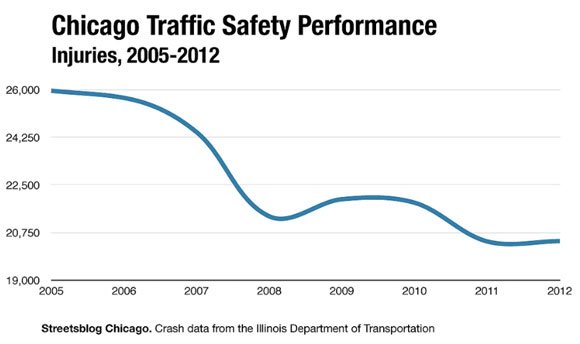
The recently released update to the Chicago Department of Transportation's first-ever two-year plan, the Chicago Forward Action Agenda, fails to give a status report on critical street safety metrics. The two-year update to Chicago Forward [PDF] does say a lot about what CDOT is doing to improve safety, but it doesn't provide information on traffic crashes and injuries.
The Chicago Forward plan laid out several performance goals, including to "reduce total roadway crashes and injuries from all roadway crashes each by 10% every year." It was an ambitious target, and one that the city is taking steps to address by redesigning streets and adding speed enforcement cameras. The update, however, includes no data on crashes and injuries. While it's too early to fully assess trends since 2010 and whether the city is doing enough to reduce traffic violence, the report should still include this safety information so Chicagoans can see the state of their city's streets.
CDOT did not respond to a query about the status of these performance measures and why they weren't listed. However, crash data is available from the Illinois Department of Transportation, and based on IDOT's numbers, total traffic injuries in Chicago declined between 2010 and 2012, but not as much as 10 percent per year. Total crashes also declined but at less than the target rate.
With only two full years of safety data, it's possible that one year might be an outlier, and 2012 does seem to be exceptional in some respects. Traffic fatalities shot up almost 18 percent last year, including a 20 percent increase in pedestrian deaths, but seem on track to drop substantially this year. (The Chicago Forward plan calls for a reduction of traffic fatalities to zero by 2021, but monitoring crashes and injuries gives a more robust picture and is less subject to random variation.)
The information we have since 2010 is still useful. Here's what IDOT data revealed about recent changes in pedestrian and cyclist injuries in Chicago:
- From 2009 to 2012 there was a marked decrease in injury crashes involving pedestrians of 16 percent, but an increase in injury crashes involving cyclists of nearly six percent. (Note that these are the number of all people injured in crashes with pedestrians and cyclists, including possible injuries to the driver and passengers.)
- From 2009 to 2012 there was a decrease in reported pedestrian crashes of 12.75 percent, but an increase in reported bicycle crashes of 7.41 percent.
Overall, the picture is improving for pedestrians while cyclist injuries are increasing. Still, it's likely that the safety of biking has increased, since more people are riding, but we need better information to track the level of cycling in the city as well. According to the Census, the number of bike commuters increased 7.43 percent from 2011 to 2012. Commute trips are a relatively small fraction of overall trips, though, so we need more information about the number of non-work trips to better understand our streets' safety performance. CDOT's bike counts, which estimate biking levels by tabulating actual cyclists at specific locations for a few hours per month, are inconveniently published in 30 separate PDFs. Chicago can do better.
CDOT's goal of a 10 percent crash and injury reduction each year set a very high bar. And it's too early to judge how tactics like speed cameras, installed in October, are affecting traffic injuries (the effects on driver speed are certainly promising). But the crash data from IDOT does suggest that it will take a lot more effort to achieve the city's street safety goals. The city needs to show people what's happening on the streets, especially if it means that we need to work harder to reduce traffic injuries and deaths.



